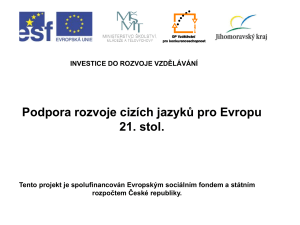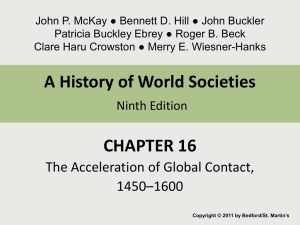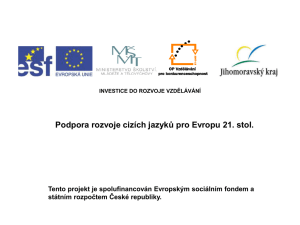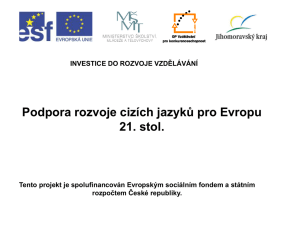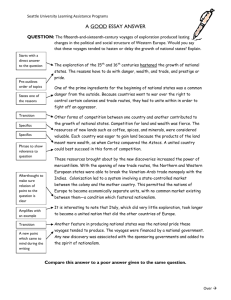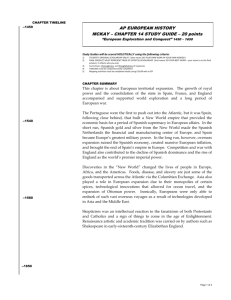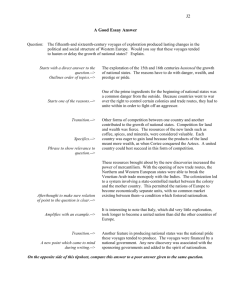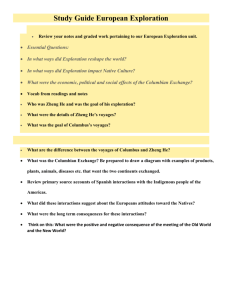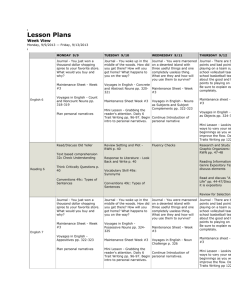VOYAGES OF DISCOVERY
advertisement
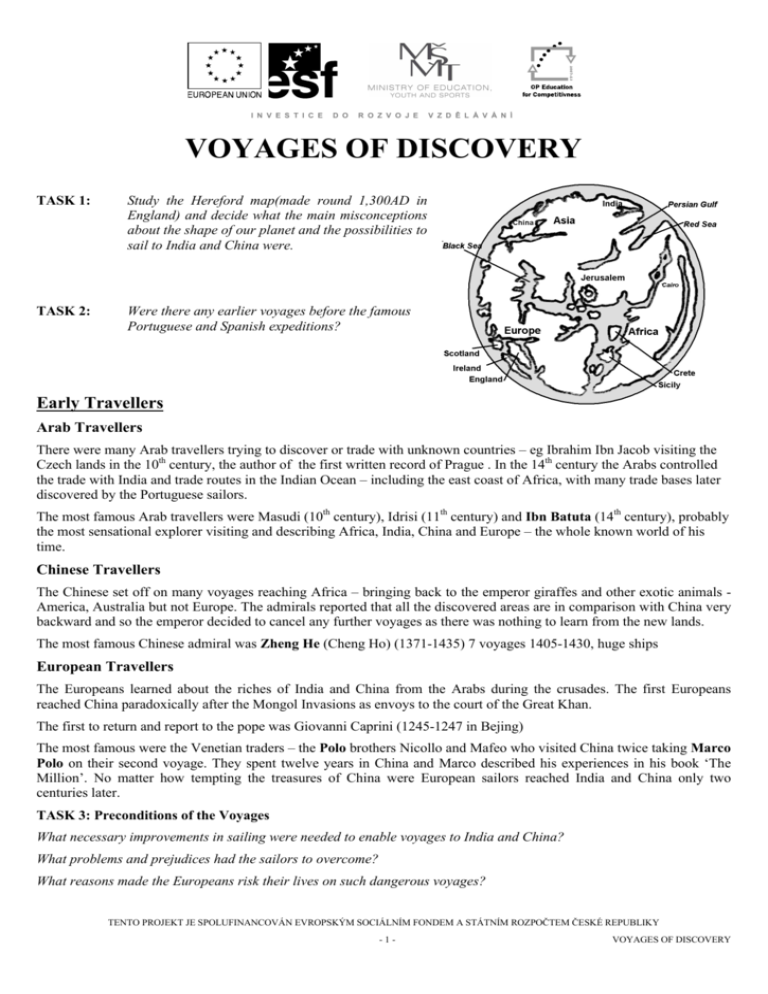
I N V E S T I C E D O R O Z V O J E V Z D Ě L Á V Á N Í VOYAGES OF DISCOVERY TASK 1: Study the Hereford map(made round 1,300AD in England) and decide what the main misconceptions about the shape of our planet and the possibilities to sail to India and China were. TASK 2: Were there any earlier voyages before the famous Portuguese and Spanish expeditions? Early Travellers Arab Travellers There were many Arab travellers trying to discover or trade with unknown countries – eg Ibrahim Ibn Jacob visiting the Czech lands in the 10th century, the author of the first written record of Prague . In the 14th century the Arabs controlled the trade with India and trade routes in the Indian Ocean – including the east coast of Africa, with many trade bases later discovered by the Portuguese sailors. The most famous Arab travellers were Masudi (10th century), Idrisi (11th century) and Ibn Batuta (14th century), probably the most sensational explorer visiting and describing Africa, India, China and Europe – the whole known world of his time. Chinese Travellers The Chinese set off on many voyages reaching Africa – bringing back to the emperor giraffes and other exotic animals America, Australia but not Europe. The admirals reported that all the discovered areas are in comparison with China very backward and so the emperor decided to cancel any further voyages as there was nothing to learn from the new lands. The most famous Chinese admiral was Zheng He (Cheng Ho) (1371-1435) 7 voyages 1405-1430, huge ships European Travellers The Europeans learned about the riches of India and China from the Arabs during the crusades. The first Europeans reached China paradoxically after the Mongol Invasions as envoys to the court of the Great Khan. The first to return and report to the pope was Giovanni Caprini (1245-1247 in Bejing) The most famous were the Venetian traders – the Polo brothers Nicollo and Mafeo who visited China twice taking Marco Polo on their second voyage. They spent twelve years in China and Marco described his experiences in his book ‘The Million’. No matter how tempting the treasures of China were European sailors reached India and China only two centuries later. TASK 3: Preconditions of the Voyages What necessary improvements in sailing were needed to enable voyages to India and China? What problems and prejudices had the sailors to overcome? What reasons made the Europeans risk their lives on such dangerous voyages? TENTO PROJEKT JE SPOLUFINANCOVÁN EVROPSKÝM SOCIÁLNÍM FONDEM A STÁTNÍM ROZPOČTEM ČESKÉ REPUBLIKY -1- VOYAGES OF DISCOVERY I N V E S T I C E D O R O Z V O J E V Z D Ě L Á V Á N Í Reasons for overseas voyages Islamic, Venetian and Genoese monopoly on trade making the goods too expensive Transport by water much cheaper and enabling to transport more than by land Main trade routes through central Asia very unsafe Ottoman expansion troubling the trade (1453 Constantinople, 1459 Serbia, 1480 Otranto, Italy) Turks imposing heavy taxes on trade Portuguese Voyages Portugal became strong and united in the course of six centuries of wars against Muslims to reconquer their territory. The struggle continued in northern Africa and Portugal began to expand. Their first important gain was Ceuta in 1415 – during the reign of King John I. (1385-1433). The most important figure for the early Portuguese voyages was his son Henry ‘the Navigator’ (1394 – 1460). He was influenced by the stories of the riches of Africa – gold, ivory, slaves and decided to go on with the expansion. To prepare well for this he gathered scholars at his court to improve ships, navigation and maps. In the course of the following decades they discovered many Atlantic islands and continued going south round the African coastline. The main discoveries: 1488 Bartholomew Diaz reached the Cape of Good Hope (actually named it Cape of Storms due to terrible weather) 1497 Vasco da Gama reached Calicut, India but he was badly surprised by the presence of Arab trade bases in eastern Africa and Arab controlled trade with India. Because of this the King of Portugal decided to send 13 ships and army to get the trade bases and trade under Portuguese control. 1500 Pedro Cabral led the above mentioned military expedition, but his fleet was caught in a storm and he discovered Brazil TASK 4: Label the map of the Portuguese voyages. TENTO PROJEKT JE SPOLUFINANCOVÁN EVROPSKÝM SOCIÁLNÍM FONDEM A STÁTNÍM ROZPOČTEM ČESKÉ REPUBLIKY -2- VOYAGES OF DISCOVERY I N V E S T I C E D O R O Z V O J E V Z D Ě L Á V Á N Í Spanish Voyages Columbus and Going West Christopher Columbus (1451-1506) a sailor from Genoa, Italy. He was influenced by a Florentine geographer, Paolo Toscanelli, and his map showing that it is much shorter to sail westwards to reach India. That was a revolutionary idea but it was extremely difficult for him to find a sponsor for his voyage. He was refused by the King of Portugal (1480), King and Queen of Spain (1486), Kings of France and England (14861492). Finally he was given the second hearing with King Ferdinand and Queen Isabella of Spain in 1492 – the year of the conquest of Granada and the end of reconquista in Spain. He got their support – one ship Santa Maria. The other two ships Pinta and Nina were provided by their owners. This was not the end of difficulties as it was almost impossible to get the necessary crew. TASK 5: Why was it so difficult to persuade sailors to join his expedition? Columbus and his voyages: 1492-1493 – sails to Bahamas (San Salvador) and Cuba (Hispaniola) 1493-1496 – West Indies 1498-1500 - West Indies 1502-1504 – Latin America TASK 6: Study the map. What ´mistake´ did Columbus and Toscanelli make? What saved Columbus? TENTO PROJEKT JE SPOLUFINANCOVÁN EVROPSKÝM SOCIÁLNÍM FONDEM A STÁTNÍM ROZPOČTEM ČESKÉ REPUBLIKY -3- VOYAGES OF DISCOVERY I N V E S T I C E D O R O Z V O J E V Z D Ě L Á V Á N Í TASK 7: Read the following extracts from Columbus’s Journal (according to a copy made by Bartholomew Las Casas – the original disappeared) and answer the questions below. Sunday, 9th September This day the Admiral made 19 leagues and he arranged to count less than the actual number, because if the voyage was long of duration, the people would not be so terrified and disheartened. Tuesday, 25th September The Admiral talked with Martin Alonso Pinzon respecting a chart (which he had sent to the caravel three days before) on which the Admiral had certain islands drawn in that sea. Martin Alonso said that the ships were in that position on which the islands were placed, and the admiral replied that so it appeared to him. Wednesday, 10th October During the night and the day they made 59 leagues, counted as no more than 44. Here the people could no longer endure. They complained of the length of the voyage. But the admiral cheered them up in the best way he could, giving them good hopes of the advantages they might gain from it. Thursday, 11th October They saw shore birds and a green reed near the ship. Those of the caravel Pinta saw a cane and a pole and they picked up another pole which seemed to be worked with iron. On board the Nina the same day they saw a small branch covered with berries. Everyone breathed afresh and rejoiced at these signs. 1. Why did Columbus decide to cheat concerning the distance covered? 2. What do you think would be Columbus’s main worry on 25th September? 3. On the 10th October they were on open sea for a month. long voyage or Did the sailors complain because of the length of the journey or were they afraid of anything else? 4. What made the sailors rejoice and why? New Continent Spanish discoveries Columbus set an example for many other explorers that actually confirmed the existence of the new continent. Alonzo de Hojeda and Amerigo Vespucci (1499-1500) South America, West Indies Vasco Nunez de Balboa 1513 crossed the Panama Straight and discovered the Pacific Ocean TENTO PROJEKT JE SPOLUFINANCOVÁN EVROPSKÝM SOCIÁLNÍM FONDEM A STÁTNÍM ROZPOČTEM ČESKÉ REPUBLIKY -4- VOYAGES OF DISCOVERY I N V E S T I C E D O R O Z V O J E V Z D Ě L Á V Á N Í English Discoveries John Cabot (1497) Labrador, Newfoundland Sebastian Cabot (1498) North America French Discoveries Jacques Cartier (1534) Newfoundland, St. Lawrence’s River Circumnavigation TASK 8: Why did the Spanish decide to send a risky expedition to sail round the world? Fernao Magellan (1519-1522) The geographers believed there must be a North-West and South-West passage round America to India. Magellan decided to use the South-West passage as the Spanish knew the coast of South America. He was given 5 ships (1 returned) and 237 sailors (18 returned) Hardships of the voyage: Problems with the crew 2 ships lost while crossing the Magellan Straight The size of the Pacific Ocean underestimated (Nov 28 – Mar 6) Magellan killed in the Phillippines Francis Drake (1577-1580) English pirate, in fact forced to circumnavigate the world by the pursuing Spanish ships. The Search for the North-West Passage Henry Hudson 1610 discovered Hudson Bay and believed it to be the Pacific Button 1612 discovered the west coast of Hudson Bay Conquest of Paradise No matter how impressive the discovery of America was the king of Spain was rather disappointed. They did not discover a new way to India, no trade, no spices and only very little gold was coming from the new continent. This was to change in a few years and thanks to undisciplined adventurers. TENTO PROJEKT JE SPOLUFINANCOVÁN EVROPSKÝM SOCIÁLNÍM FONDEM A STÁTNÍM ROZPOČTEM ČESKÉ REPUBLIKY -5- VOYAGES OF DISCOVERY I N V E S T I C E D O R O Z V O J E V Z D Ě L Á V Á N Í Aztec Empire The Aztecs arrived in Mexico in the 13th century and made it the centre of their empire. They lived in big, advanced stone cities – capital Tenochtitlan 100,000 inhabitants. However, in the 15th century their empire was declining due to internal weakness and the opposition of neighbouring tribes. The Aztec were highly unpopular because of their cruelty, human sacrifices and harsh rule. The Spanish learned about Aztec wealth and sent an expedition to establish a port as a trading base. 1519-1521 Hernando Cortez used this opportunity and without any order set off to conquer the empire with only 400 foot soldiers and 15 horsemen. The Emperor Montezuma invited them to Tenochtitlan, where Cortez took him prisoner and ruled in the name of Montezuma. The Spanish brought with them small-pox and half of the Indians died of this illness. In the end Cortez was given the title of Governor of New Mexico by the Spanish king. Inca Empire The Inca civilization was at its peak when the Spanish arrived. They controlled a large area, built even better cities than the Aztecs, built roads connecting their cities, had no problems with neighbours. The problem was that there was a civil war between two candidates shortly before the Spanish arrived. Francesco Pizzaro and Diego de Almagro (1530-1532) Pizzaro had only 106 soldiers and 62 horsemen but managed to conquer the empire and defeat the Inca army in the Battle of Cajamarca and took the emperor Atahualpa prisoner. TASK 9: How were the Spanish able to defeat armies so superior in numbers? Thanks to the two conquests Spain became the richest colonial power. Aztec and Inca gold and silver was melted and sent to Spain – irresistible temptation for pirates in service of England and France. More Voyages, More Discoveries TASK 10: Use the atlas and find out who discovered the following places. Write down the name of the explorer and the country he served. a. Spitsbergen, Novaya Zemlya b. Tasmania c. Tahiti d. New Zealand e. Bering Strait f. Hawaii g. Easter Islands TENTO PROJEKT JE SPOLUFINANCOVÁN EVROPSKÝM SOCIÁLNÍM FONDEM A STÁTNÍM ROZPOČTEM ČESKÉ REPUBLIKY -6- VOYAGES OF DISCOVERY I N V E S T I C E D O R O Z V O J E V Z D Ě L Á V Á N Í Results of the Voyages TASK 11: Work in groups. What was the effect of the voyages on Europe and America? Write down the results/effects of the voyages on Europe and America. Europe America TASK 12: Put the following events into the correct chronological order. a. Cortez conquered the Aztec Empire 1. b. Cook discovered the Hawaii Islands 2. c. Bartholomew Diaz reached the Cape of Good Hope 3. d. Columbus reached the Bahamas 4. e. Vasco da Gama reached India 5. f. 6. Pizzaro destroyed the Inca Empire g. Voyages of Zheng He 7. h. Francis Drake and his circumnavigation 8. TASK 13: Label the picture of the legendary Francis Drake´s Golden Hind. Would you like to sail round the Word on a ship this size? TENTO PROJEKT JE SPOLUFINANCOVÁN EVROPSKÝM SOCIÁLNÍM FONDEM A STÁTNÍM ROZPOČTEM ČESKÉ REPUBLIKY -7- VOYAGES OF DISCOVERY
